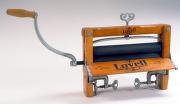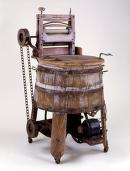|

Clothes Wringer

Clothes Wringer

Woman washing

"Red Electric" Washing and Wringing Machine
|
Summary and Objective
Students will participate in a comparative study of laundering clothes through the years to understand the impact that invention/technology has had on the completion of chores. Students will sequence pictures, experiment with tools, and attempt to make a spot disappear. Students will complete Venn diagrams to record comparisons as well as charts to identify washing times and results of stain removal.
Teaching Plan
Step 1.
Print out copies of the Clothes Wringer (2), Four-legged washtub, "Woman Washing", "Red Electric" Washing and Wringing Machine, a present day washing machine, and the illustration from the Grade 4 ELA MCAS (spring '05) "The Mustard Seed" illustration p. 14 http://www.doe.mass.edu/mcas/2005/release/g4ela.pdf.
Step 2.
Have the students sequence the seven (7) pictures chronologically and explain their reasons for placements. (Reorganize as needed and discuss.) Develop a K-W-L chart* with the following questions: What would have been involved in washing an article of clothing for given tools? What would make clothes difficult to wash? How would stains have been removed? How often would clothes be washed? Who would have responsibility for the laundry? When would laundry be done? How long might it take for: one article of clothing...per person...per family? *The K-W-L chart is used at the beginning of the lesson or unit as a "brainstorming" activity. The title could be LAUNDRY CHORES -- PAST TO PRESENT, while the columns could be labeled: We KNOW: We WANT to know: We LEARNED:. The first two columns are filled out prior to instruction and activities, and the final column is completed throughout the lesson or unit. Students may find that some of the items in the "KNOW" column are incorrect and need to be modified. They can also check off "WANT to know" questions with the answers once discovered or researched. In the end, the chart serves as documentation of both process and learning. A chart can be located at:
http://www.eduplace.com/graphicorganizer/pdf/kwl.pdf
Step 3.
Present the "Great Wash Out" challenge. Divide the students into groups and present them with their tools. Group 1: washtub, rocks, soiled t-shirt, water, timer. Group 2: washtub, wash-board, soiled t-shirt, water, timer. Group 3: washtub, wringer (gloves for a student's hands to twist the cloth, an old mop bucket insert, or roller laminator are possibilities), soiled t-shirt, soap, water, timer. Group 4: washtub, agitator (shaking) and spinner (salad spinner), soiled t-shirt, soap, water, timer. Group 5: washtub, soiled t-shirt, spot remover, water, timer. Group 6: Results from using a washing machine outside the school setting (possible extra credit work/homework for volunteers). Have students use a "Scientific Method" worksheet to record results of their attempts to clean the spot. On the sheet, students should indicate which of the 7 pictures their trial closely represents.
Step 4.
Each group will present its laundered t-shirt and identify the time necessary for spot removal.
Step 5.
Record group results on chart-sized Venn diagrams and note times and spot removal results on a chart-sized line graph.
Step 6.
Discuss and summarize the effect of changes in technology and the introduction of inventions on the chore of washing clothes. Compare time on tasks and need for actual manual labor.
Step 7.
As an extension, students could test various types of stains and conduct further observations. Making soap and dyes could follow.
Step 8.
As part of a unit, students could research and compare other chores, then and now.
|




